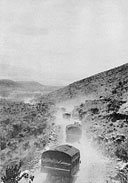
3
Setting the Stage
When Major H. H. Coldicott and Captain B. A. R. Jones, on 28 May 1940 selected a site at Kabete, 19 miles outside Nairobi and 6,209 feet above sea-level, for a South African base depot and camp, they figuratively if not actually turned the first sod in the digging of foundations for an administrative organization which was to transform the scene in East Africa. Colonel A. J. Orenstein, C.M.G., the South African who was Director of Medical Services on East Africa Force Headquarters, and Captain H. Mullins, Staff Captain 'W', approved the site. Here, on 16 June, No. 2 Section of 16th Field Company, S.A.E.C. detrained while the rest of the company--less No. 3 Section dropped at Mombasa--went on to Nairobi, where Major H. D. W. Smith, the Company Commander, was told that his company would be responsible for constructing camps for South African troops not only at Mombasa and Kabete, where 10th Field Ambulance, S.A.M.C., was already established, but also at Nairobi, Gilgil and Tigoni. Helping to prepare for the reception of fighting formations at Gilgil were also 1st S.A. Divisional Petrol Company, a Divisional Field Butchery and Divisional Field Bakery of the S.A. 'Q' Services Corps, while the 1st Divisional Ammunition Company, 'Q' S.C., with headquarters and seven sections, was settling in at Kabete.
The South African Engineers had begun an immense task, for which the Corps had been expanded beyond recognition since the mobilization of 5th Field Company, S.A.E.C, on 20 May 1940 as a first step in the calling up of engineers to swell the ranks of a branch of the Defence Force which shortly before the outbreak of war numbered only 423 officers and men.1
TOPOGRAPHY
To appreciate the problems facing East Africa Force, whom the South Africans were to help, the topography of Kenya itself must be considered, as it dictated the lines on which the services, especially the engineers, transport companies and field ambulances, would have to develop and operate. The frontier of Kenya and Italian East Africa stretched for 1,200 miles from Lake Rudolf to the Indian Ocean between Lamu and Kismayu, and throughout almost its entire length it ran through bush and semi-desert, except where it traversed a rocky but green escarpment at Moyale, near which some efforts had been made at


